The Great Depression & WW II
War in the Air
The United States wasn’t very well prepared for war in the air in 1941.
In the Pacific area, they only had 900 airplanes against 3,000 Japanese planes. But America’s industries started making airplanes as many factories switched from making cars to planes. By 1944, America had 10,000 aircraft stationed in the Pacific.
In Europe, American planes started bombing German forces in 1942, but with heavy losses. For example, during one week in August 1942, 153 airplanes with their crews were lost over Germany.
This too changed as America made more advances in technology and put more planes into production. By February 1944, more than 6,000 bombers (airplanes that dropped bombs on ground targets) hit Germany in one week.
Flying bombing runs could be terrifying. Bombers would fly in formations. Enemy fighter planes would fly in and out of the formation spraying the bombers with machine gun bullets and cannon shells. anti-aircraft flak would come up from the ground, sometimes exploding harmlessly, other times tearing holes in the airplane.
If hit, planes might try to make it back to their home base. Other times the crewmen, if still alive, had to parachute out over enemy territory. If an airman survived his airplane’s crash over enemy territory, he would be captured and put in a prisoner of war camp.
Unless other U.S. pilots saw the crash, often the first news about a crew would be when they didn’t arrive back at their base. Even then, people didn’t know if the crew was dead or alive until the German government notified the International Red Cross, sometimes months later. It would be a very difficult wait for the crew members’ families at home.
By June 1944, the German air force was no longer able to fully attack Allied bombers, which meant the Allied casualty rate went down. The American air dominance over France helped make the D-Day invasion in 1944 a success.
In the Pacific Theater , airplanes were essential in moving men and supplies to fighting areas in the China-Burma-India area. They had to fly over the Himalaya mountain chain in planes that had a maximum flying altitude about equal to the top of the mountains.
Bombers also made runs over Japan. This included the 1945 runs which dropped atomic bombs on the Japanese cities of Hiroshima and Nagasaki.
Tennessean Charles Seay joined up after Pearl Harbor, but had to wait until he turned 18 to enter flight school. He recalls his service in the Pacific.
Tennessean Charles Seay joined up after Pearl Harbor, but had to wait until he turned 18 to enter flight school. He recalls his service in the Pacific.
We had a lot of night harasser missions. The Japanese would send one plane over and keep us awake all night, so we’d retaliate the next night. We’d send over one plane and keep them awake all night….
But, it was interesting to fly at night and to come within view of a city….you’d just get into sight, and suddenly it would go black….and you’d get over the target and suddenly the lights would go on like that--the searchlights. And they would just come and just grab you like a Venus flytrap would grab a fly, and…you’re suddenly in a cone of light and it’s so bright in there that you have to duck down in the cockpit.
And you have to go on instruments because you can’t look out. So now they’re firing their anti-aircraft [guns] at you and you don’t know where they’re going off ‘cause you can’t look, and you start evasive maneuvers on instruments. And that is an experience. Because you can hardly tell which way is up anyway, and you’re doing all kinds of crazy maneuvers.. And after a while you’d realize, okay, you’re out of the lights.
The U.S. also used airborne troops during the war. These men wore parachutes and jumped from airplanes behind enemy lines. This was a dangerous job. The soldiers might be injured or killed in the fall, or be shot at while parachuting. Once on the ground, they had to join up with other soldiers and attack enemy positions.
Occasionally the danger came from their own troops, such as in Sicily when Allied ground troops mistakenly opened fire on their own transport planes, killing or wounding 229 paratroopers.
Occasionally the danger came from their own troops, such as in Sicily when Allied ground troops mistakenly opened fire on their own transport planes, killing or wounding 229 paratroopers.
Picture Credits:
- A F6F-3 airplane, known as the Hellcat, takes off from the USS Lexington, an aircraft carrier, which in November 1943, was located in the Pacific Ocean. The man in front has signaled with a flag that the pilot had permission to take off. U.S. Navy photograph now in the National Archives
- A U.S. Air Force machine gunner fires at enemy planes from a bomber over Europe in 1942. Notice how limited his view is. He can only see airplanes that are flying directly under the opening in his airplane. National Archives
- U.S. aircraft mechanics change out a B-17 Flying Fortress engine at an air base in England sometime in 1944. United States Air Force
- The crew of a B-17 bomber pose in front of their aircraft. Sumner County resident Jack Marschall is in the front row, second from the left. Sumner County Archives, Volunteer Voices, Digital Library, University of Tennessee Knoxville
- Members of the ground crew of a U.S. Air Force squadron in Italy attach loaded wing tanks to a P-51 Mustang before it takes off on a mission of escorting bombers over enemy targets. The extra fuel tanks are needed for long-distance flights. National Archives
- LCdr. Paul Buie briefs pilots of VF-16s aboard the aircraft carrier USS Lexington on their mission in 1943. U.S. Navy Military History online images
- The crew of the "Memphis Belle" B-17 Flying Fortress stands in front of the airplane at an air base in England in 1943 after becoming one of the first U.S. bombers to complete 25 missions over enemy territory. The airplane received its nickname in honor of the pilot's girlfriend, who lived in Memphis. U.S. Air Force
- A wounded pilot is removed from his airplane aboard the carrier USS Saratoga near the Solomon Islands in the Pacific in November 1943. Even wounded, the pilot was able to fly his plane back and land it on the ship. U.S. Navy
- A P-51 fighter pilot, showing the stress of combat, takes a break after seven hours of escort duty over Europe. The writing on the back of his hand were the coordinates given at the pre-flight briefing. Courtesy U.S. Air Force
- A group of "Flying Fortresses" from the U.S. Army 8th Air Force leave vapor trails in the sky over Germany. Courtesy of the National Air and Space Museum
- Besides bombing runs, airplanes were also used to supply troops in the field. Airplanes drop supplies on the 4th Infantry Division in Germany on Feb. 13, 1945, after rains made the roads impassable. The supplies consisted of food rations, gas, and ammunition. U.S. Army
The Great Depression & WW II >> World War II >> Fighting the War >> War in the Air
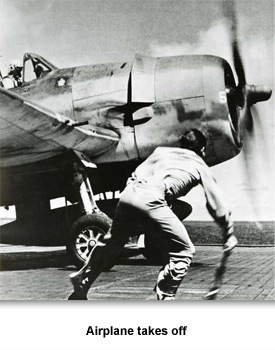
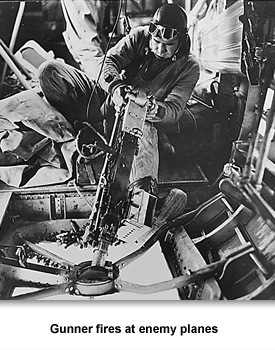
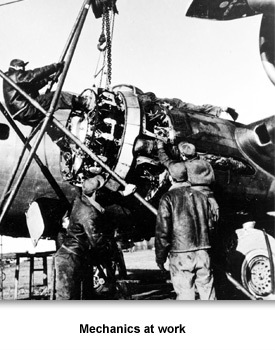
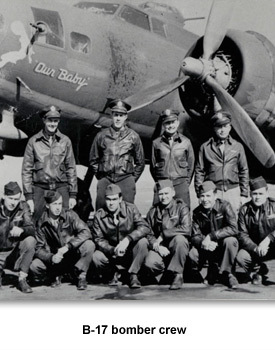
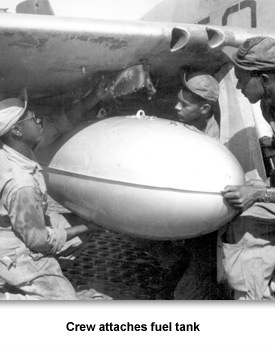
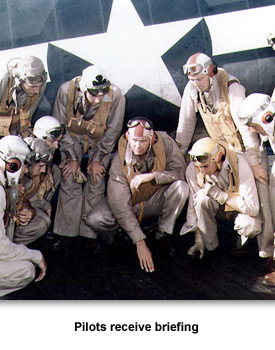
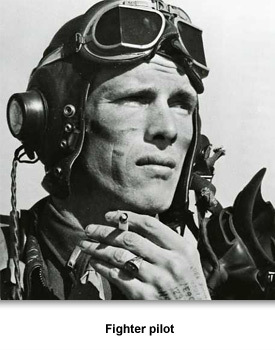
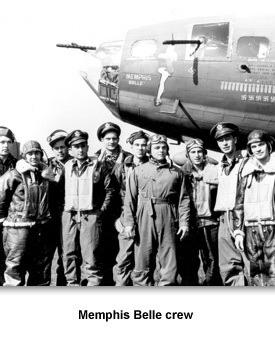
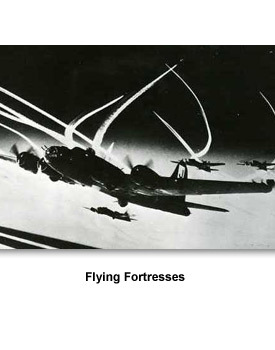
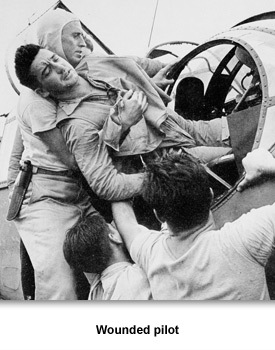
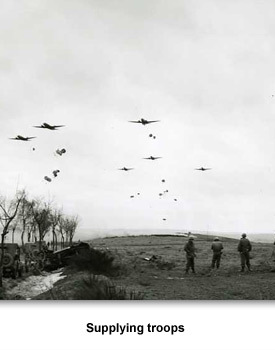
 Sponsored by: National Endowment for the Humanities
Sponsored by: National Endowment for the Humanities